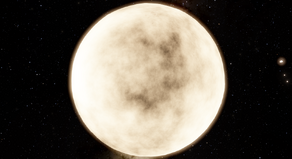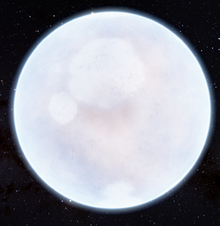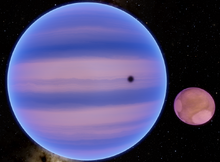Chav is the home star of the Vesqkels. Chav is a K1 V type star, also known as an orange dwarf. It's absolute magnitude is 5.75. Chav has 10 planets. One of them, Kaan-Bul, had life at first. Nowadays, all of the planets and their moons are inhabited in some way or another. Chav lives in the galaxy Mas Pon, which is 500 mly away from the Via Lactea Galaxy.
Formation
The Chav system started out as a huge planetary nebula, about 1 light year wide. The gasses clumped together to form larger clumps, which clumped together again to form yet larger clumps. They eventually collected in the center, initially as two stars, which later merged into one star. The merger threw out lots of stellar debris, which later formed the outer gas giant, Jaj, and its 10 large moons and 56 dwarf moons (66 in all).
Planets
Chav has 10 planet: two S-class planets, three J-class planets, one N-class, two I-class, one D-class, and one E-class. The planets also has a combined total of 23 different moons of varying classes.
Laj

Day side of Laj, taken during an intersteller vacation, 17,483 BC
Laj is the planet nearest to Chav. It was known since ancient times. It is a hot S-class planet that orbits at 0.09 AU from Chav. It is 2110 km wide, and has 4 moons, all of them small dwarf moons. It is very difficult to see in the sky, and can only be seen around the equinoxes of Kaan-Bul and when it is furthest from Chav. Its moons were not discovered until 39,689 BC, when Discovery III was sent to study the 3 inner planets. It is tidally locked and orbits every 10.63 days. It has a temperature of 831*F. Because of these conditions, it is extremely difficult to live on this planet, so Vesqkels occupy this planet in the twilight areas. It has not been terraformed as of 10,000 AD. It has no axial tilt.

Laj, seen in 39,688 BC, Discovery III approach
Maj

First good image of Maj, taken by Discovery III in 39,689 BC. Taken in grayscale due to storage and transmission limitations of the time.
Maj is the second planet from Chav. It has been known since ancient times, like Laj. Maj has no moons, and orbits at 0.167 AU. It has a diameter of 4,149 km, nearly twice that of Laj. Maj orbits every 27.7 days, and is also tidally locked. It has a surface gravity of about 30% that of earth, and no axial tilt. Its surface has many craters, meaning it has had quite a rough past. It has a temperature of 457*F, and is a hot S-class planet with no atmosphere. Vesqkels inhabit the twilight zones, just like Laj. It greatly resembles Laj in many ways, and is basically a larger, colder version of it. Maj is much easier to observe in the sky, although still a bit difficult. You have to see around twilight hours, and when it is a decent distance from Chav, sort of like observing Venus from Earth.

Maj, seen at 39,447 BC, upon first Vesqkel arrival
Naj

Naj taken by Discovery III, in 39,691 BC, Chav on top and Laj, Maj, and Baj to the right, and a dwarf moon on the left

Naj, taken in 39,703 BC by space telescope
Naj is the third planet from Chav. It has been known since ancient times, like Laj and Maj, because you can easily see it in the sky. It has a blue appearance, and is a hot D-class planet with 3 dwarf moons, which were discovered by telescope around 39,788 BC. It has a thick blue, earthlike atmosphere that is mainly oxygen, meaning it could be habitable. Unfortunately, at over 600*F, the temperature makes it unfit for life. Terraforming of this planet was very difficult, and it got messed up, so the project was scrapped and not touched since. A large portion of its temperature comes from its orbit at 0.265 AU, and the rest comes from its atmosphere. Naj is also tidally locked, and orbits every 56 days. It closely resembles Mars, except that it has a thick atmosphere, unlike Mars. Its surface does not have many craters, but has mountains clumped together in groups. Like Laj and Maj, it has no axial tilt. It is easy to observe, once Chav is below the horizon.
Baj

Baj's moon/asteroid system
Baj is the fourth planet from Chav. It is a warm or temperate, (depending on its location in is orbit), blue and white striped J-class 146,430 km wide. It is the brightest object in the sky, other than Chav and Kaan-Bul's two moons. It can be seen in the day under optimal circumstances, and blazes in the night sky. Baj has 30 moons, although it only has one major moon: Bab, which is visible with a small telescope. Baj orbits at 0.409 AU in 106.58 days. It rotates in 2.06 days, and its temperature ranges from 73-110*F. It has a small axial tilt of 0* 45', so seasons are more affected by its slight eccentricity rather than its axial tilt, like on Earth. Currently, there's floating citities on Baj, and its temperature makes it quite fit for life. Unfortunately, the clouds do not have oxygen, so Vesqkels must wear oxygen suits. Its gravity is 2.4x that of earth.
Bab

Bab passing in front of Baj, causing an eclipse shadow
Bab is the only major moon of Baj. It is a purple-red, scorched D-class planet. Most of the purple color comes from its atmosphere. Its surface resembles that of most D-class planets. Like all moons, it is tidally locked to Baj, and orbits every 12 hours 17 minutes. Because of its close proximity to Baj, it can have a weird "cat's eye" appearance when Baj lights up the dark side of Bab. It orbits at 184,000 km from Baj, and because of tidal heating, is over 1,000*F. It's gravity is a little under 0.3g, meaning you weigh alot less on Bab.
